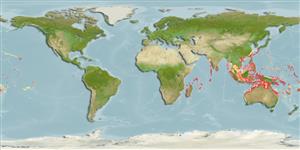Teleostei (teleosts) >
Carangiformes (Jacks) >
Carangidae (Jacks and pompanos) > Caranginae
Etymology: Caranx: French, carangue, the name of a Caribbean fish; 1836 (Ref. 45335).
More on authors: Alleyne & MacLeay.
Environment: milieu / climate zone / depth range / distribution range
Ecology
Marine; brackish; reef-associated; non-migratory; depth range 1 - 50 m (Ref. 89972). Tropical; 31°N - 34°S, 26°E - 135°W
Indo-Pacific: Zanzibar, Tanzania and South Africa to Caroline and Marquesan islands, north to the Ryukyu Islands, south to Australia.
Size / Weight / Age
Maturity: Lm ? range ? - ? cm
Max length : 88.0 cm TL male/unsexed; (Ref. 9710); common length : 55.0 cm FL male/unsexed; (Ref. 3287); max. published weight: 6.4 kg (Ref. 4699)
Dorsal spines (total): 9; Dorsal soft rays (total): 21 - 23; Anal spines: 3; Anal soft rays: 16 - 19. Brassy to yellowish green dorsally, shading to silvery on side with scattered dark spots (becoming more numerous with age), conspicuous silvery white spot just behind upper rear edge of opercle, dusky upper caudal fin lobe, and bright yellow to dusky lower lobe with narrow white border (Ref. 90102, Ref. 48635). Body oblong and compressed; dorsal profile moderately convex to second dorsal fin, ventral profile slightly convex. Breast scaleless ventrally, usually with small patch of prepelvic scales. Adipose eyelid weakly developed. (Ref. 90102)
Inhabit lagoon and seaward reefs, occasionally entering rivers. Juveniles found in estuaries. Swims high over bottom (Ref. 48635). Solitary or in schools (Ref. 90102). Feed primarily on fishes. Excellent food fish (Ref. 12484).
Life cycle and mating behavior
Maturities | Reproduction | Spawnings | Egg(s) | Fecundities | Larvae
Oviparous, distinct pairing during breeding (Ref. 205).
Paxton, J.R., D.F. Hoese, G.R. Allen and J.E. Hanley, 1989. Pisces. Petromyzontidae to Carangidae. Zoological Catalogue of Australia, Vol. 7. Australian Government Publishing Service, Canberra, 665 p. (Ref. 7300)
IUCN Red List Status (Ref. 130435)
Threat to humans
Harmless
Human uses
Fisheries: minor commercial; aquaculture: commercial; gamefish: yes
Tools
Special reports
Download XML
Internet sources
Estimates based on models
Preferred temperature (Ref.
123201): 24.5 - 28.8, mean 27.6 °C (based on 586 cells).
Phylogenetic diversity index (Ref.
82804): PD
50 = 0.5000 [Uniqueness, from 0.5 = low to 2.0 = high].
Bayesian length-weight: a=0.01738 (0.01108 - 0.02725), b=2.96 (2.84 - 3.08), in cm total length, based on LWR estimates for this species & Genus-body shape (Ref.
93245).
Trophic level (Ref.
69278): 4.0 ±0.5 se; based on diet studies.
Resilience (Ref.
120179): Medium, minimum population doubling time 1.4 - 4.4 years (Preliminary K or Fecundity.).
Fishing Vulnerability (Ref.
59153): High vulnerability (55 of 100).
Nutrients (Ref.
124155): Calcium = 24.2 [11.1, 46.5] mg/100g; Iron = 0.426 [0.232, 0.830] mg/100g; Protein = 20.3 [18.1, 22.7] %; Omega3 = 0.129 [0.076, 0.224] g/100g; Selenium = 45.2 [22.5, 100.3] μg/100g; VitaminA = 45.9 [14.4, 142.2] μg/100g; Zinc = 0.531 [0.376, 0.785] mg/100g (wet weight);
